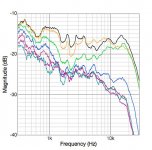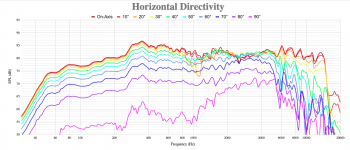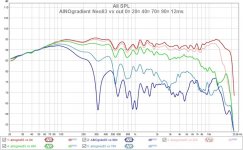What are these "advantages of the sonic strengths of dipole reproduction in homes"the advantages of the sonic strengths of dipole reproduction in homes don't apply to low bass.
Big ESL, Martin Logan or Magnepan are actually not good dipoles, they have VERY problematic dispersion. And as per pics, most owners put them in corners...I've been a keen advocate of dipole ESLs (nearly full range large panels) since early '70s. But.....
the advantages of the sonic strengths of dipole reproduction in homes don't apply to low bass. Nothing is gained by struggling with very large baffles (I had one) or enormous EQ boost with a sub.
While I don't believe in "matching" box types, I think the real sound quality pairing of dipoles is with a large corner horn (Klipschorn).
B.
By the way latest ML have monopole bass with dsp. Test in Stereophile 2016
https://www.stereophile.com/content...-renaissance-esl-15a-loudspeaker-measurements
Last edited:
With the great increase in interest in dipoles these days, must be lots of people who could answer better for me. (Previously, the very idea of open-backed cabs were totally anathema since textbook readers believed the rear wave comes around to destroy the front wave.) Of course, there used to be great interest in tapped "horns", so popularity may not mean much.What are these "advantages of the sonic strengths of dipole reproduction in homes"
Some advantages are (1) not a box and (2) works with the room to create satisfying orchestral sound.
Odd to find Juhazi criticizing the ML dispersion when his link shows excellent dispersion beyond 45-degrees. My music room has only one chair, unfashionable sound absorbing furnishings (like wall to wall carpet with underlayer) and DSP so dispersion (or FR for that matter) isn't a problem for me. For sure, the sound quality in other respects swamps the shortcoming of dispersion front or rear.
B.
I didn't critizice ML, but panels in general. ML is propably the best, being curved
Sorry, measurements below are from different sources, different methods, but all 0-90deg.
Magnepan SLR by ASR - horizontal https://www.audiosciencereview.com/forum/index.php?threads/magnepan-lrs-speaker-review.16068/
and ML by Stereophile
vs. narrow baffle multiway



Sorry, measurements below are from different sources, different methods, but all 0-90deg.
Magnepan SLR by ASR - horizontal https://www.audiosciencereview.com/forum/index.php?threads/magnepan-lrs-speaker-review.16068/
and ML by Stereophile
vs. narrow baffle multiway



Last edited:
As we learn from Toole, dispersion index and total power need to be digested together to understand human perception (also known as "sound quality") in a room. So, while DI for large non-curved panels can't match hypothetical point sources, the total picture to the human listener takes more into account. And dipoles have that "more" and boxes do not.
My large home-brew panels are composed of 6 ESL panels and mounted on a curve. Dayton-Wright argued that that geometry would represent a point source a few feet behind the panel. I don't know if that is correct, but sounds good, eh.
B.
My large home-brew panels are composed of 6 ESL panels and mounted on a curve. Dayton-Wright argued that that geometry would represent a point source a few feet behind the panel. I don't know if that is correct, but sounds good, eh.
B.
+-4db response linearity on-axis and than the same deviation off axis which results in the same dispersion as a 10+ inch cone driver I wouldn't call excellent, not even remotely acceptable imo. If this is excellent for you then what is bad, I cannot imagine it any worse? A pair of Neumann KH120 A, have a response linearity of +-1db and those cost like 600 a piece, so about 20x times less, I would hope that if you spend 20x times as much it gets better not worse, but that may be me...Some advantages are (1) not a box and (2) works with the room to create satisfying orchestral sound.
Odd to find Juhazi criticizing the ML dispersion when his link shows excellent dispersion beyond 45-degrees.
Also absurd comment, I think it is pretty well known here that on and off-axis linearity is a big part of the perceived sound and one cannot just eq direcitivity problems away anyway, even than why buy such an expensive speaker to than have to fix it yourself at home?My music room has only one chair, unfashionable sound absorbing furnishings (like wall to wall carpet with underlayer) and DSP so dispersion (or FR for that matter) isn't a problem for me.
??? By far the number one property of what makes a speaker good audibility wise is frequency response of the on and off axis sound, so I am not sure how you imagined the fact that it is a dipole or panel speaker is going to swamp that huge shortcoming??For sure, the sound quality in other respects swamps the shortcoming of dispersion front or rear.